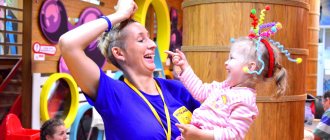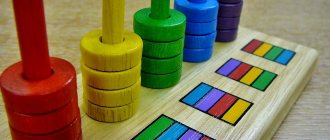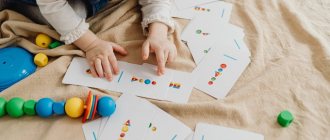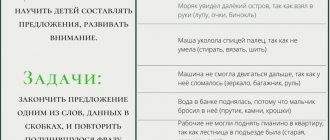“We walked in Africa” (game for children 5–7 years old)
Children stand in a circle or scattered.
The teacher shows the movements and pronounces the text, the children repeat the movements.
We walked around Africa (Stamp our feet.) And collected bananas. (They depict how they collect bananas.) I’ll give it to mom, I’ll give it to dad (We knock on the right knee, then on the left.) And we won’t deprive ourselves. (We knock on the chest with our right and left hands.) Suddenly a huge gorilla (We draw a large circle with our hands.) Almost crushed me. (We knock on the chest with our right and left hands.) I’ll give it to mom, I’ll give it to dad (Knock on the right, then the left knee.) And I won’t deprive myself. (Knock on the chest with our right and left hands.)
“Ball” (game for children 5–7 years old)
Children stand in a circle or scattered.
The teacher shows the movements and pronounces the text, the children repeat the movements.
Ten, nine, (Clap their hands.) Eight, seven, (Slap their knees.) Six, five, (Clap.) Four, three, (Slap.) Two, one. (They clap.) We are with the ball (They cover their eyes with either the inside or the outside of their palm.) We want to play. We just need to find out: (They clap for every word.) Who will have the ball (They stomp for every word.) Catch up. (They squat.)
Outdoor game “What is hidden?”
Purpose: to train children to distinguish primary colors, etc., to develop visual memory
How to play: Children stand in a circle or in a line. The teacher places 3-5 objects on the floor in front of the children (a cube, a flag, a rattle, a ball, etc.) and asks them to remember them. Then, at the teacher’s signal, the players turn their backs to the center of the circle or face the wall. The teacher hides one or two objects and says: “Look!” Children turn to face the center of the circle and look closely at the objects, remembering which ones are not there. The teacher approaches some of the children in turn, and they whisper in a whisper what objects are hidden. When most of the players correctly name the hidden objects, the teacher calls them out loud.
If toys are used in the game, it is better to select toys of the same type, depicting either animals, birds, or trees. The game can be played this way: only one child turns away when the teacher removes the objects, and then determines which object is hidden. The rest of the players should not give him any hints.
T.I.Osokina “Physical education in kindergarten” (second junior group)
Outdoor game “Don’t be late!”
Goal: to train children to act on a signal, run in different directions simultaneously as a whole group, use the entire area of the hall, and find their toy.
How to play: Cubes or rattles are laid out in a circle on the floor. Children stand near the cubes. At the teacher’s signal, they run around the entire room without touching each other or knocking over the cubes. At the signal “Don’t be late!” children run to their blocks.
T.I.Osokina “Physical education in kindergarten” (second junior group)
Outdoor game "Bubble".
Goal: to train children to stand in a circle, act in accordance with the text of the poem, and use the entire area of the hall.
How to play: Children and their teacher join hands and form a small circle, standing close to each other. To the words: “Blow up, bubble, blow up big, stay like that, but don’t burst!” the children move back, holding hands until the teacher says: “The bubble has burst!” At this signal, the kids lower their arms and squat down, saying: “Clap!” You can after the words “The bubble burst!” Invite the children, without breaking their hands, to move towards the center of the circle, while saying “sh-sh-sh” (the air comes out). Then “inflate the bubble” again.
T.I.Osokina “Physical education in kindergarten” (second junior group)
Outdoor game "My funny ringing ball."
Goal: to train children to jump on two legs in place, to use the entire area of the hall.
Progress of the game:
Children sit on chairs on one side of the hall. The teacher stands in front of them at some distance and does exercises with the ball. It shows how easily and high a ball can jump when you hit it with your hand. At the same time, the teacher says: “My cheerful ringing ball, where did you start galloping? Red, yellow, blue, I can’t keep up with you!” Then he calls the children and invites them to jump with the ball. Again he does exercises with the ball, accompanying them with reading poetry. Having finished the poem, he says: “I’ll catch up now!” The children stop jumping and run away from the teacher, who pretends to catch them.
T.I.Osokina “Physical education in kindergarten” (second junior group)
Source
“Five Names” (game for children 5–7 years old)
Children are divided into two teams.
Two players, a boy and a girl (representatives of two teams), stand next to each other in front of two lines.
At the signal, they must walk forward (first one, then the other), taking five steps, and for each step, without the slightest error or hesitation (without breaking the rhythm), pronounce a name (boys - the names of girls, girls - the names of boys). This is a seemingly simple task, but in reality it is not so easy to complete.
You can name five other words (animals, plants, household items, etc.). There are many names, but not everyone can pick up five names and pronounce them one after another without delay in the rhythm of a step.
The winner is the one who copes with this task or is able to name more names.
“Three, thirteen, thirty” (game for children 5–7 years old)
They choose a driver. The players stand in a circle and open with outstretched arms. The driver stands in the center of the circle. When playing the game for the first time, it is advisable that the teacher be the driver.
The teacher explains that if he says: “Three,” all the players put their hands to the sides; if he says: “Thirteen,” everyone puts their hands on their belts; if he says: “Thirty” - everyone raises their hands up (you can choose any movements).
The teacher quickly names one movement or another. The player who made a mistake sits on the floor. When 1-2 players remain in the circle, the game ends; The winners are announced.
Outdoor games for the middle group
Marina Timeryanova
Outdoor games for the middle group
Outdoor game “Cook and kittens”
Goal: to train children in various types of walking or running, to develop reaction speed, dexterity, and the ability to focus on words.
Game description: According to a counting rhyme, a cook is selected who will guard the objects lying in the hoop - “sausages”. The cook walks inside a hoop, a cord - the “kitchen”. Children - kittens walk in a circle, performing various types of walking, running, saying the text:
Pussies are crying in the corridor,
Kittens have great grief:
Tricky cook for poor pussies
Doesn't let you grab the sausages.
With the last word, the “kittens” run into the “kitchen”, trying to grab the sausage. The cook is trying to insult the running players. The affected players are eliminated from the game. The game continues until all the sausages are stolen from the cook. The winning kitten becomes a chef.
You can’t run into a circle too early. The cook is not allowed to grab the kittens, only salt them, he is not allowed to go outside the circle. It is prohibited to take 2 or more items at the same time.
Outdoor game "Vivode"
Goal: to train children in rolling, throwing and catching a ball, in the ability to coordinate movement with words, to develop attention and dexterity.
Description of the game: Players in a circle roll the ball from one to another, saying:
-The apple rolls into the round dance circle,
-Whoever raised him is the governor...
The child who has the ball at this moment is the governor. He says:
-I am the governor today.
-I'm running from the round dance.
Runs around the circle, puts the ball on the floor between two players. The children say in chorus:
One, two, don't be a crow
And run like fire!
Players run in a circle in opposite directions, trying to grab the ball before their partner. The one who ran first and grabbed the ball rolls it in a circle. Game continues.
Roll or throw the ball only to the player standing next to you. You cannot interfere with a player running behind a circle. The first one to touch the ball wins.
Outdoor game “Find where it’s hidden”
Goal: to learn how to navigate a room or area, perform actions when given a signal.
Game description: Children stand along the wall. The teacher shows them the object and says that he will hide it. The teacher invites the children to turn to the wall. After making sure that none of the children is looking, he hides the object, and then says: “It’s time!” Children begin to look for the object.
Outdoor game “At the bear in the forest”
Goal: To teach children to alternately perform different functions (run away and catch).
Description of the game: The bear's den (at the end of the site) and the children's house at the other are determined. Children go for a walk in the forest and perform movements according to the verse, which they recite in chorus:
By the bear in the forest,
I take mushrooms and berries,
But the bear doesn't sleep
And he growls at us.
As soon as the children finished saying the poem, the bear gets up with a growl and catches the children, they run home.
Outdoor game “Find and remain silent”
Goal: learn to navigate in the hall. Cultivate endurance and ingenuity.
Game description: The teacher shows the children an object, and after they have closed their eyes, he hides it. Then he offers to look, but not to take it, but to tell him in his ear where it is hidden. Whoever finds it first is the leader in the next game
Outdoor game “Fox in the chicken coop”
Goal: to develop in children dexterity and the ability to perform movements on a signal, to practice running with dodging, catching, climbing, and deep jumping.
Game description: A chicken coop is outlined on one side of the site. In the chicken coop, chickens are located on a roost (on benches), and children stand on benches. On the other side of the site there is a fox hole. The rest of the place is a yard. One of the players is assigned to be a fox, the rest are chickens - they walk and run around the yard, pecking grains, flapping their wings. At the signal “Fox,” the chickens run into the chicken coop, climb onto the perch, and the fox tries to drag away the chicken that did not have time to climb onto the perch. He takes her to his hole. The chickens jump off the roost and the game resumes.
The fox can catch chickens, and chickens can climb onto a perch only when the teacher gives the signal “Fox!”
Outdoor game "Hares and Wolf"
Goal: to develop in children the ability to perform movements on a signal, to practice running, jumping on both legs, squatting, and catching.
Description of the game: One of the players is assigned to be a wolf, the rest portray hares. On one side of the site, the hares mark their places with cones and pebbles, from which they lay out circles or squares. At the beginning of the game, the hares stand in their places. The wolf is at the opposite end of the site - in the ravine. The teacher says: “The bunnies jump, hop - hop - hop, onto the green meadow. They nibble the grass and listen to see if a wolf is coming.” The hares jump out of the circles and scatter around the site. They jump on two legs, sit down, nibble the grass and look around in search of the wolf. The teacher says the word “Wolf”, the wolf comes out of the ravine and runs after the hares, trying to catch and touch them. The hares each run away to their own place, where the wolf can no longer overtake them. The wolf takes the caught hares to his ravine. After the wolf catches 2-3 hares, another wolf is chosen. Hares run out at the words - hares gallop. You can return to your place only after the word “Wolf!”
You cannot catch those hares to whom the mother hare gave her paw. Place stump cubes on the way, the hares run around them. Choose 2 wolves. The wolf has to jump over the obstacle - a stream.
Outdoor game “Find yourself a partner”
Goal: To develop in children the ability to perform movements according to a signal, according to a word, quickly forming pairs. Practice running and color recognition. Develop initiative and ingenuity.
Game description: The players stand along the wall. The teacher gives each person one flag. At the teacher’s signal, the children scatter around the playground. At another signal, or at the word “Find yourself a pair!”, children with flags of the same color find a pair, each pair, using the flags, makes one or another figure. An odd number of children participate in the game; 1 must remain without a pair. The players say: “Vanya, Vanya - don’t yawn, quickly choose a pair!”
The players get into pairs and scatter at the signal (word) of the teacher.
Each time players must have a pair.
Use handkerchiefs instead of flags. To prevent children from running in pairs, introduce a limiter - a narrow path, jump over a stream.
Outdoor game “Migration of birds”
Goal: develop a response to verbal signals. Practice climbing the gymnastic ladder.
Game description: Children stand at one end of the hall, they are birds. At the other end of the hall is a tower (gymnastic wall). At the teacher’s signal: “The birds are flying away!” — the birds fly with their wings spread. At the signal “Storm!” - birds fly to the tower - they hide from the storm in the trees. After the words: “The storm has stopped,” the birds fly again.
Outdoor game “Shepherd and flock”
Goal: strengthen the ability to play according to the rules of the game. Practice crawling on all fours around the hall.
Game description: They choose a shepherd, give him a horn and a whip. Children depict a herd (cows, calves, sheep). The teacher says the words:
Early in the morning
Shepherd: “Tu-ru-ru-ru.”
And cows suit him well
They sang: “Moo-moo-moo.”
Children perform actions according to the words, then the shepherd drives the herd into the field (to the designated lawn, everyone wanders around it. After a while, the shepherd cracks his whip and drives the herd home.
Outdoor game "Mousetrap"
Goal: to develop children’s self-control, the ability to coordinate movements with words, and dexterity. Exercise in running and squatting, forming in a circle and walking in a circle.
Description of the game: the players are divided into two unequal teams, the big one forms a circle - a “mousetrap”, the rest - mice. Words:
Oh, how tired the mice are,
Everyone gnawed, everyone ate.
Beware of the cheat,
We'll get to you.
Let's set up mousetraps,
Let's catch everyone now!
Then the children lower their hands down, and the “mice” remaining in the circle stand in a circle and the mousetrap increases in size.
Outdoor game “Burn, Burn Clear!”
Goal: to develop children's self-control and spatial orientation. Practice running fast.
Game description:
The players stand in a column in pairs. A line is drawn in front of the column at a distance of 2-3 steps. The “catcher” stands on this line. Everyone says:
Burn, burn clearly, so as not to go out.
Look at the sky - Birds are flying,
The bells are ringing! One, two, three - run!
After the word “run,” the children standing in the last pair run along the column (one on the left, the other on the right, trying to grab the hands in front of the catcher, who tries to catch one of the pair before the children have time to meet and join hands. If the catcher succeeds to do, then he forms a pair and stands in front of the column, and the remaining one is the catcher.
Outdoor game “Circle Traps”
Goal: to develop in children the ability to coordinate movements with words. Practice rhythmic walking, running with dodging and catching, and lining up in a circle.
Description of the game: children stand in a circle, holding hands. The trap is in the center of the circle, with a bandage on the arm. The players move in a circle and say:
We, funny guys, love to run and jump.
Well, try to catch up with us. One, two, three - catch it!
The children run away, but the trap catches up. The caught one temporarily moves aside. The game continues until the trap catches 2-3 children. Duration 5-7 minutes.
Outdoor game "Wolf in the Moat"
Goal: to develop courage and dexterity, the ability to act on a signal. Practice running long jumps.
Description of the game: two parallel straight lines are drawn on the site at a distance of 80 - 100 cm - a “ditch”. A “goat house” is outlined along the edges of the site. The teacher appoints one player as a “wolf”, the rest as “goats”. All goats are located on one side of the site. The wolf stands in the ditch. At the teacher’s signal “wolf in the ditch,” the goats run to the opposite side of the site, jumping over the ditch, and the wolf tries to catch (touch) them. Those caught are taken to the corner of the ditch. Game duration is 5-7 minutes.
Outdoor game “Homeless Hare”
Goal: to develop spatial orientation in children. Exercise fast running
Description of the game: a hunter and a homeless hare are selected from among the players. The rest of the players - the hares - draw circles for themselves - “their own house.” A homeless hare runs away, and the hunter catches up with him. A hare can escape from a hunter by running into any circle; then the hare standing in the circle becomes a homeless hare. If the hunter catches them, they switch roles. Game duration 5-7 minutes
Outdoor game "Owl"
Goal: to develop in children inhibition, observation, and the ability to perform movements on a signal. Exercise children in running.
Description of the game: at a distance of 80 - 100 cm, two straight lines are drawn - this is a “ditch”. At a distance of one or two steps from the border, the “goat’s house” is outlined. All goats are located on one side of the site. The wolf stands in the ditch. At the signal “wolf in the ditch,” the goats run to the opposite side, jumping over the ditch, and the wolf at this time catches the goats. Those caught are taken to the corner of the ditch. Duration 6-8 minutes.
Outdoor game “Firemen in training”
Goal: to develop in children a sense of collectivism, the ability to perform movements on a signal. Practice climbing and forming a column.
Description of the game: children line up facing the gymnastics wall at a distance of 5–6 steps in 3–4 columns. A bell is suspended against each column at the same height. At the signal “1, 2, 3 - run,” the children standing first run to the wall, climb in and ring the bell. Then they descend and stand at the end of their column. Repeat the game 6-8 times.








